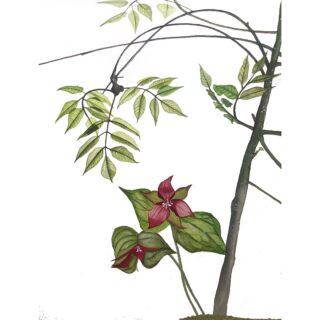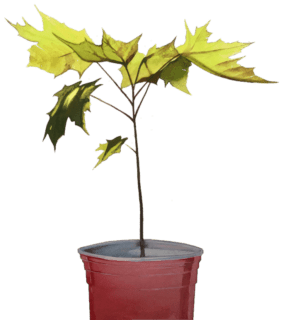 May at Hubbard Brook is a month of anticipation. Deciduous trees in the Hubbard Brook Valley are peppered with buds; birds returning from spring migration chatter across territory lines; red trillium, mayapple, and other spring ephemerals erupt from the forest floor in fleeting patches of sunlight. Professor of Biology at Dartmouth College Matt Ayres has been sending regular email updates to the Hubbard Brook listserv with leaf-out forecasts for the main bird plots in the experimental forest. The latest update, sent on May 10, forecasts budburst for sugar maple, beech, and birch this Saturday, May 14, with trees reaching 90 percent leaf expansion ten days later. Ayres’ forecast is generated by a computer model that incorporates air temperature, day length, and three decades of phenological observations. Our perception of seasons in the northern forest is inextricably linked to trees, so we observe the emergence of leaves with a bit of reverence. The forest resurrecting itself demands our respect.
May at Hubbard Brook is a month of anticipation. Deciduous trees in the Hubbard Brook Valley are peppered with buds; birds returning from spring migration chatter across territory lines; red trillium, mayapple, and other spring ephemerals erupt from the forest floor in fleeting patches of sunlight. Professor of Biology at Dartmouth College Matt Ayres has been sending regular email updates to the Hubbard Brook listserv with leaf-out forecasts for the main bird plots in the experimental forest. The latest update, sent on May 10, forecasts budburst for sugar maple, beech, and birch this Saturday, May 14, with trees reaching 90 percent leaf expansion ten days later. Ayres’ forecast is generated by a computer model that incorporates air temperature, day length, and three decades of phenological observations. Our perception of seasons in the northern forest is inextricably linked to trees, so we observe the emergence of leaves with a bit of reverence. The forest resurrecting itself demands our respect.
What causes this resurrection, exactly? Budburst has been documented at Hubbard Brook every year since 1989 by Amey Bailey, a Forest Technician from the USDA Forest Service. Bailey has been recording the leaf development of beech, yellow birch, and sugar maples at nine locations in the Hubbard Brook Valley, including both low- and high-elevation plots. According to Bailey’s observations, the date of budburst at 500 meters (~1600 feet) above sea level has ranged between May 2 and May 24 during the last 32 years. Models developed by US Forest Service Ecologist Nina Lany and extended by Ayres and his students, show that the timing of budburst involves both sunlight (length of day) and air temperature.
Buds that are presently turning into leaves developed last summer and autumn, but remained quiescent, or dormant, throughout the winter and early spring. While dormant, a bud is similar to an embryo. All of the cells that will eventually form the young leaf are present, waiting for the environmental signals of the arriving spring to initiate internal chemical processes. The historical data indicate that buds of sugar maple in the Hubbard Brook forest break dormancy on about March 22, and buds of beech and yellow birch break dormancy about eight days later. The activation of bud metabolism is apparently cued by increasing day lengths, which are sensed in plant cells through biochemical recognition of a spike in the longer wavelengths of light that dominate during sunrise and sunset, when the sun’s rays pass further through the atmosphere. Following the break in dormancy, bud development proceeds at a rate determined by temperature. The minimum temperature for this cellular activity to occur is about 4 ℃ (~39 ℉). Any hours when temperatures exceed this threshold contribute to bud development. Scientists record this timeframe in degree days, which are the number of degrees celsius over this 4 ℃ thermal base, reached by a day’s maximum temperature. For example, if an early spring day reaches 14 ℃ (~57 ℉), that would be recorded as 10 degree days. The three most common hardwood tree species at Hubbard Brook display budburst after about 179 degree days since the end of bud dormancy. So early springs at Hubbard Brook occur when temperatures in April and early May are warmer than average.
For me, anticipating leaf-out brings a familiar nervous excitement. When I was a child, I tried to ‘save’ the maples that took root in the middle of my parents’ yard by carefully transplanting them into cups, mugs, and old flower pots. Each seedling, vying for impossible life, was miraculous, and I felt my young trees’ survival linked to my own well-being. Reading Ayres’ spring forecasting emails from Hubbard Brook reminds me of my childhood hours observing budburst in my cultivated yard seedlings. There was nothing more relieving than finding green buds beading along a supple gray stem, and nothing more heart-wrenching than finding one of my trees crushed, gnawed, or shriveled. I tended a small forest in mismatched containers and watered and shaded and examined them with the attention of a bird turning her eggs. Sometimes now, as an adult, I’ll spot a young maple that’s rooted itself in a parking lot and I’ll take a moment to notice its intricately veined leaves, barely unfurled, a glossy anchor between past and present, parking lot and yard and forest.
 Innumerable life processes depend on the chemical reactions that occur within buds in response to light and heat. We too are influenced by the changes in our forest, shifting ratios of red and blue light, the onset of warm days. Seasonal markers such as leaf-out become part of our ecological identities over time, and for many of us, spring marks the end of the school year, travel home, the beginning of a new field season, adapting to a new routine. For us and for the forest, the month of May bears witness to the turning of many leaves. As the canopy fills and we enter the spring 2022 field season at Hubbard Brook, may we strive to notice the details of our forest that are peripheral to our individual areas of study: from the tiniest veined leaf to the neatest row of scales, from the blooming thunderheads to thin strands from which inchworms twist. May we especially take delight in our ability to witness these things together this year.
Innumerable life processes depend on the chemical reactions that occur within buds in response to light and heat. We too are influenced by the changes in our forest, shifting ratios of red and blue light, the onset of warm days. Seasonal markers such as leaf-out become part of our ecological identities over time, and for many of us, spring marks the end of the school year, travel home, the beginning of a new field season, adapting to a new routine. For us and for the forest, the month of May bears witness to the turning of many leaves. As the canopy fills and we enter the spring 2022 field season at Hubbard Brook, may we strive to notice the details of our forest that are peripheral to our individual areas of study: from the tiniest veined leaf to the neatest row of scales, from the blooming thunderheads to thin strands from which inchworms twist. May we especially take delight in our ability to witness these things together this year.
